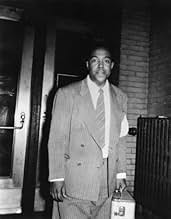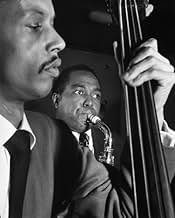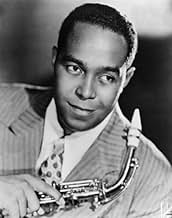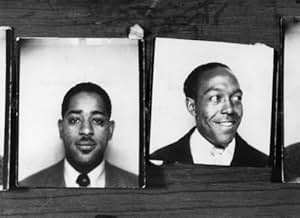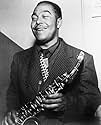Charlie Parker(1920-1955)
- Music Department
- Composer
- Soundtrack
Charles Christopher Parker Jr. was born on August 29, 1920, in a suburb
of Kansas City, Missouri, to Charles Parker Sr. and his 18-year-old
wife Addie. His father ran out on the family when Charlie was just a
little boy. When he was 11 his mother bought him an alto saxophone for
his birthday. By the time he was 15 Charlie was working as a musician
in the flourishing Kansas City jazz scene. He also began drinking
heavily and using drugs, which were also a part of the KC jazz scene,
as were illegal after-hours gambling casinos.
Charlie became more experienced by playing with various bands, including those of Lawrence Keyes and Harlan Leonard, before joining Jay McShann's band in 1940. The band was widely heard on radio across the country, so Charlie's saxophone playing became well known, even though people didn't know his name, so he became known as the Yardbird, or just The Bird. While still in Kansas City, Charlie reached a breakthrough: tired of playing solo with the same scales, he discovered that if he used a higher interval of the chords from a popular song or melody line, with a pianist or guitarist adding the appropriate new chords, he finally could play the sound he always had been hearing in his head. Essentially turning the melody line inside out, he began experimenting with this new style, which became known as "bebop".
Charlie played with McShann in New York City until 1942, when he left for brief stints with the bands of pianist Earl 'Fatha' Hines and singer Billy Eckstine. The association with the Hines Orchestra was a significant one because of the other musicians, who included trumpeter Dizzy Gillespie. By 1945 Charlie was back in New York and leading his own small groups. He got married, but continued to live like a nomad, traveling from place to place and spending almost every other night in a hotel or boarding house. He also became a drug addict, and as his addiction increased so did his appetite, and he began putting on weight.
Charlie took part in the first bebop recording session in 1945. With Gillespie and Miles Davis, he recorded songs like "Billie's Bounce" and "Koko" for Savoy Records. Not long afterward, he recorded such classic songs as "A Night in Tunisia" and "Yardbird Suite" for another small label, Dial Records. In the late 1940s Charlie toured Europe, where he was received like visiting royalty. He made several tours of Cuba, where he began experimenting with large string sections and Afro-Cuban rhythms. After a few years of relative stability, however, Charlie began a downward slide. He got hooked back on drugs again (heroin was his favorite), he began nodding out on bandstands, getting into fistfights and pawning his saxophones for drug money. Aware of the effects of drug use, he chastised younger sax players who emulated his heroin use.
By the early 1950s Charlie's drinking and drug use made him gray and prematurely lined. His self-abuse began to infringe on his musical ability. During this time, Charlie was befriended by a wealthy European baroness who was living in New York, loved his jazz music and helped him out when he needed it. In early 1955, on his way to a gig in Boston, Charlie stopped by her apartment for a visit. Alarmed by his obvious ill health, she had her personal doctor examine him, which revealed that he had stomach ulcers and many other health problems, the result of his years of drinking and drug use. The doctor recommended hospitalization, but the stubborn Charlie refused to consider it. The baroness got him to rest at her place for a few days.
On March 12, 1955, the baroness found Charlie Parker dead, slumped over in an easy chair in front of the TV set in her apartment. He was 34 years old. An autopsy revealed such damage to the inside of his body that the doctor who performed the autopsy thought Charlie was a man at least 50 years old. Charlie Parker's legend grew even larger after his death. Fans scrawled "Bird Lives!" on walls of jazz clubs from New York, to Los Angeles, to Paris, France. To this day, more than 40 years after his death, Bird remains jazz's single most venerated figure.
Charlie became more experienced by playing with various bands, including those of Lawrence Keyes and Harlan Leonard, before joining Jay McShann's band in 1940. The band was widely heard on radio across the country, so Charlie's saxophone playing became well known, even though people didn't know his name, so he became known as the Yardbird, or just The Bird. While still in Kansas City, Charlie reached a breakthrough: tired of playing solo with the same scales, he discovered that if he used a higher interval of the chords from a popular song or melody line, with a pianist or guitarist adding the appropriate new chords, he finally could play the sound he always had been hearing in his head. Essentially turning the melody line inside out, he began experimenting with this new style, which became known as "bebop".
Charlie played with McShann in New York City until 1942, when he left for brief stints with the bands of pianist Earl 'Fatha' Hines and singer Billy Eckstine. The association with the Hines Orchestra was a significant one because of the other musicians, who included trumpeter Dizzy Gillespie. By 1945 Charlie was back in New York and leading his own small groups. He got married, but continued to live like a nomad, traveling from place to place and spending almost every other night in a hotel or boarding house. He also became a drug addict, and as his addiction increased so did his appetite, and he began putting on weight.
Charlie took part in the first bebop recording session in 1945. With Gillespie and Miles Davis, he recorded songs like "Billie's Bounce" and "Koko" for Savoy Records. Not long afterward, he recorded such classic songs as "A Night in Tunisia" and "Yardbird Suite" for another small label, Dial Records. In the late 1940s Charlie toured Europe, where he was received like visiting royalty. He made several tours of Cuba, where he began experimenting with large string sections and Afro-Cuban rhythms. After a few years of relative stability, however, Charlie began a downward slide. He got hooked back on drugs again (heroin was his favorite), he began nodding out on bandstands, getting into fistfights and pawning his saxophones for drug money. Aware of the effects of drug use, he chastised younger sax players who emulated his heroin use.
By the early 1950s Charlie's drinking and drug use made him gray and prematurely lined. His self-abuse began to infringe on his musical ability. During this time, Charlie was befriended by a wealthy European baroness who was living in New York, loved his jazz music and helped him out when he needed it. In early 1955, on his way to a gig in Boston, Charlie stopped by her apartment for a visit. Alarmed by his obvious ill health, she had her personal doctor examine him, which revealed that he had stomach ulcers and many other health problems, the result of his years of drinking and drug use. The doctor recommended hospitalization, but the stubborn Charlie refused to consider it. The baroness got him to rest at her place for a few days.
On March 12, 1955, the baroness found Charlie Parker dead, slumped over in an easy chair in front of the TV set in her apartment. He was 34 years old. An autopsy revealed such damage to the inside of his body that the doctor who performed the autopsy thought Charlie was a man at least 50 years old. Charlie Parker's legend grew even larger after his death. Fans scrawled "Bird Lives!" on walls of jazz clubs from New York, to Los Angeles, to Paris, France. To this day, more than 40 years after his death, Bird remains jazz's single most venerated figure.



